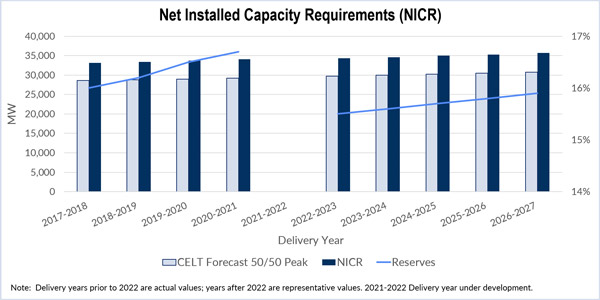WESTBOROUGH, Mass. — ISO-NE’s 2017 Economic Study will reflect the same basic assumptions and use the same profiles as those in the 2016 study, while representing some incremental changes to the former study’s third scenario. Marianne Perben, manager of resource adequacy and technical studies, outlined the 2017 study’s scope of work to the Planning Advisory Committee on Thursday, saying it will produce metrics similar to those in the 2016 report being completed now.
The 2017 study will include analysis that the Conservation Law Foundation requested at the April PAC meeting. The CLF wants the grid operator to determine whether there are viable system topologies other than those analyzed in Scenario 3 of the 2016 study with similar total system emissions but a lower relative annual resource cost.
Strong Mass. Economy Nudges up 2017 CELT Load Forecast
The 2017 Capacity, Energy, Loads and Transmission Report shows a reduced RTO load forecast from 2016 but predicts an increase in load for the Southeast New England area because the Massachusetts economy is growing faster than those in other New England states.
ISO-NE system planner Manasa Kotha on Wednesday presented a report on future capacity requirements, which credited some of the increase to changes in the operating company distribution of the load to the buses, and some to the Massachusetts economy, which is expected to grow at a compound annual growth rate of 2.1% through the forecast horizon.
The report covers net installed capacity requirements (ICR) for capacity commitment periods 2022/23 through 2026/27, ranging from 34,300 MW in the first cycle covered to 35,700 MW in the last.
The load forecast is net of behind-the-meter solar PV resources. Energy efficiency is treated separately — modeled as a supply-side capacity resource in the ICR calculations.
For additional background, Kotha referred participants to a Reliability Committee presentation on the ICR Values for CCP 2020/21 covered by Forward Capacity Auction 11.
Locational Reserves Good in Key Load Centers

Generation and transmission additions expected to be completed by 2019 will ensure sufficient operating reserves in Greater Boston, Greater Connecticut and Greater Southwest Connecticut through 2021, according to a report on reserve needs for major import areas.
Forward reserve requirements for the Northeast Massachusetts/Boston zone have ranged from 300 to 500 MW for the last three summers, and 0 MW for the winters. The report calls for 279 MW this summer and 200 to 650 MW for 2018, dropping to 0 to 50 MW after the addition of the 674-MW Footprint Power quick-start combined cycle plant at Salem Harbor, which is expected online by the end of the year.
ISO-NE resource adequacy planner Fei Zeng, who presented the report to the PAC on Wednesday, said that fast-start resources near those major load centers provide flexibility to the grid.
— Michael Kuser



